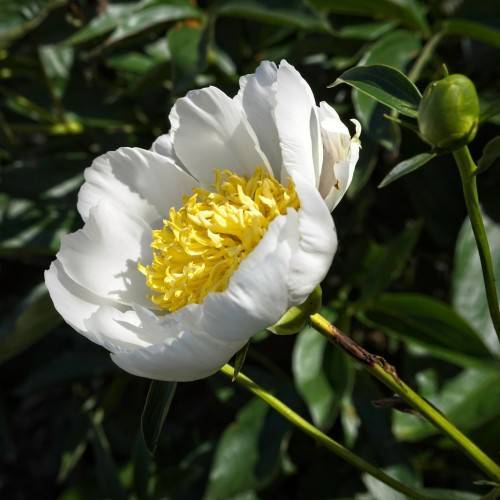
peony
Paeonia lactiflora 'Toro-No-Maki'
Cycle:
Herbaceous Perennial
Watering:
Average
Hardiness Zone:
3 - 8
Flowers:
Flowers In Spring
Sun:
Full sun,part shade
Leaf:
Yes
Growth Rate:
High
Maintenance:
Moderate
Care Level:
Medium
watering
This peony species requires regular watering during the spring and summer months to enable optimal growth. To properly water your plant, use lukewarm water and do it deeply. The best time to water this variety of peony is early in the morning so that the soil has all day to dry out. During the warmer months, water your peony at least once a week but ensure that the soil is still damp but not wet after watering. In periods of intense heat, you should also water your peony more frequently. During the cooler and winter months, decrease your frequency of watering to 2 to 3 times per month. When watering a peony, always avoid wetting the foliage as it can encourage disease.
sunlight
Peony (Paeonia lactiflora 'Toro-No-Maki') typically thrives with at least 6 hours of full sunlight each day. However, in areas where temperatures remain high throughout the day, partial shade should be provided during the hottest part of the afternoon to ensure the plant remains healthy. With sufficient sunlight, peonies will bloom in late spring/early summer. When planted in a spot with only partial sunlight, blooming may occur later than usual and flower production may be reduced.
pruning
Peony (Paeonia lactiflora 'Toro-No-Maki') plants should be pruned annually for vigorous growth and best blooming display. Pruning should take place in late winter or early spring, before new growth begins. First, remove dead, diseased, and crossing branches to allow for better air circulation. Cut any stems that have become too tall or are blocking the sunlight from other stems. Then cut away any stems that are not producing a sufficient number of flowers or are overcrowded. Cut just above a leaf bud at a 45-degree angle. Pruning should also be done to shape the plant, removing longer stems to allow for sideshoots. To encourage more flowers, cut off the spent flowers from the previous season immediately after blooming. By deadheading, you will allow for new blooming stems to come into view. Finally, give your peony a general trim-down to remove any unneeded growth. This pruning will help the plant and keep it looking healthy for the upcoming growing season.
FAQ
Is the Peony popular flower in Canada?
Yes, the peony is a popular flower in Canada. It is highly prized for its showy blooms and long-lasting beauty. Peonies have been cultivated in Canada for centuries, and their popularity is due in part to their long-lasting blooms and hardiness in colder temperatures. Peonies are a popular choice in Canadian gardens, and flower arrangements. They are also used in bouquets and centerpieces, where their stunning colors really shine.
Are Peonies fragrant?
Yes, peonies are quite fragrant. Depending on the variety of peony, the scent can be described as sweet, floral, and citrusy. Some of the most popular and aromatic varieties of peony include 'Pillow Talk', 'Fairy Tale', and the 'Duchess De Nemours'. Peonies are often used in floral arrangements and can even be grown in your garden for a fresh, summery scent.
Can Peonies be grown in partial shade?
Yes, peonies can be grown in partial shade. While they require at least 6 hours of sunlight per day during the first half of the growing season, the second half is best if the plants can receive a few hours of shade. As long as the area is not completely shaded, the peonies should do well. These plants are also hardy, so they can generally thrive in a variety of locations.
Do Peonies require well-drained soil?
Yes, peonies do require well-drained soil in order to grow and flourish. Planting them in heavy clay soil can cause the roots to rot, as the soil will stay wet for too long. To ensure good drainage and aeration, it is recommended that the soil is amended with organic matter like compost or peat moss. The soil should also be slightly acidic, with a pH of 6.0-7.0. Additionally, peonies may need to be watered more often during the summer, as they are prone to wilt in hot temperatures.
Should Peonies be staked to prevent damage?
Yes, it is a good idea to stake peonies to prevent damages. Peonies are naturally tall and floppy flowers and as such, can easily be damaged by strong winds and heavy rain. Staking is a great way to keep tall peonies from sprawling or falling over which could damage the stems or flowers. When staking your peony, use tall, sturdy stakes that support the main stem of the plant. You can use metal or bamboo stakes, but be sure to avoid stakes with sharp edges or points as those could damage the plant or injure those tending the garden. Utilizing a supporting structure for your peony will help it to look its best.
Is the Peony a long-lived perennial plant?
Yes, the Peony is a long-lived perennial plant. It can live for more than 20 years in the proper conditions, and can even last for generations with proper care and maintenance. Peonies prefer cooler climates, and well-drained soil with a relatively high pH level. They will grow to approximately 2 -3 feet in height, with heart-shaped foliage and blooms in shades of white, pink, and red. Peonies typically bloom in late spring or early summer months and make an excellent addition to any garden.
